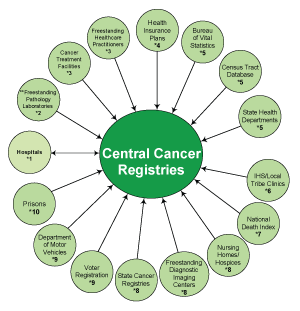Central Cancer Registries

A central cancer registry (CCR) collects, processes, and analyzes data on all cancer cases diagnosed in a defined geographic area. Each state in the United States has a CCR.
The central cancer registry business use case diagram shows the business process of a central cancer registry and its interaction with internal actors (those who perform the process) and external actors (recipients of the process).
The central cancer registry operations use case diagram shows the hierarchical grouping of central cancer registry operations, starting with the general top-level functions and followed by the more detailed second-level functions.
The central cancer registry domain diagram shows the interactions between the entities involved in registry functions. It shows the formation of a cancer abstract from the time individual event reports are generated at different data sources to the time the cancer abstract is stored in the central cancer registry and made available to institutions and national programs for research.
Central cancer registry functions include—
Central cancer registry data sources include—
*Numbers rank the data sources on the quality of useful data available on a scale of 1 being the most useful and 10 being the least useful.
**Pathology laboratories send data to both hospital registries and central cancer registries.
|